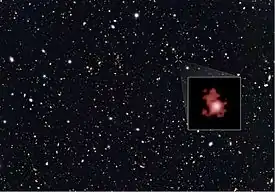KELT-9b
KELT-9b is an exoplanet—more specifically, an ultra-hot Jupiter—that orbits the late B-type/early A-type star KELT-9,[2] located about 670 light-years from Earth.[2] Detected using the Kilodegree Extremely Little Telescope, KELT-9b was announced in 2016.[3][1]
 Artist's impression of KELT-9b and its parent star | |
| Orbital characteristics | |
|---|---|
| 0.03462+0.00110 −0.00093 AU | |
| 1.4811235±0.0000011[1] d | |
| Inclination | 86.79±0.25[1] |
| Star | HD 195689 |
| Physical characteristics | |
Mean radius | 1.891+0.061 −0.053[1] RJ |
| Mass | 2.88±0.84[1] MJ |
Mean density | 530±0.15 kg m−3 |
| Temperature | 4050±180[1] K |
Host star
The surface temperature of the host star, KELT-9, is 10,170 K, unusually hot for a star with a transiting planet. Prior to the discovery of KELT-9b, only six A-type stars were known to have planets, of which the warmest, WASP-33, is significantly cooler at 7,430 K; no B-type stars were previously known to host planets. KELT-9, classified as either B9.5-A0[1] or A1,[4] could be the first B-type star known to have a planet. KELT-9b occupies a circular but strongly inclined orbit a mere 0.03462 AU from KELT-9 with an orbital period of less than 1.5 days.[5][6]
Physical properties

KELT-9b is a relatively large giant planet at about 2.8 times the mass of Jupiter; however, given that its radius is nearly twice that of Jupiter, its density is less than half that of Jupiter. Like many hot Jupiters, KELT-9b is tidally locked with its host star.[6] The outer boundary of its atmosphere nearly reaches its Roche lobe, implying that the planet is experiencing rapid atmospheric escape[7] driven by the extreme amount of radiation it receives from its host star.[6][5] In 2020, atmosphere loss rate was measured to be equal to 18 - 68 Earth masses per billion years.[8]
As of January 2020, KELT-9b is one of the hottest known exoplanets, with dayside temperatures approaching 4,600 K, warmer than many low-mass stars.[1][2] Molecules on the day side are broken into their component atoms, such that normally sequestered refractory elements can exist as atomic species, including neutral and singly ionized atomic iron[9] (Fe and Fe+) and singly ionized titanium (Ti+),[10] only to temporarily reform once they reach the cooler night side.[2] Surprisingly, spectra taken in 2021 have unambiguously indicated a presence of metal oxides and hydrides in planetary atmosphere.[11]
Thermosphere layer of KELT-9b is expected to heat up to 10000-11000 K, driven by ionization of heavy metals atoms like iron.[12]
| Jupiter | KELT-9b |
|---|---|
 |
 |
See also
References
- Gaudi, B. Scott; et al. (5 June 2017). "A giant planet undergoing extreme-ultraviolet irradiation by its hot massive-star host" (pdf). Nature. 546 (7659): 514–518. arXiv:1706.06723. Bibcode:2017Natur.546..514G. doi:10.1038/nature22392. ISSN 1476-4687. PMID 28582774. S2CID 205256410. Retrieved 2017-06-06.
- Brennan, Pat; Cofield, Calia (24 January 2020). "For Hottest Planet, a Major Meltdown, Study Shows". NASA. Retrieved 24 January 2020.
- Collins, Karen A.; Stassun, Keivan; Gaudi, B. Scott; Beatty, Thomas G.; Zhou, George; Latham, David W.; Bieryla, Allyson; Eastman, Jason D.; Siverd, Robert; Crepp, Justin R.; Pepper, Joshua (2016). "KELT-9b: A Case Study in Dynamical Planet Ingestion by a Hot Host Star". American Astronomical Society. 47: 204.03. Bibcode:2016DDA....4720403C.
- Jensen, K. S. (1981). "Spectral Classification in the MK System of 167 Northern HD Stars". Astronomy and Astrophysics Supplement. 45: 455. Bibcode:1981A&AS...45..455J.
- KELT-9 b Exoplanet Exploration Program 2017
- NASA JPL, Pasadena CA (5 June 2017) Astronomers Find Planet Hotter Than Most Stars
- Yan, Fei; Henning, Thomas (2 July 2018). "An extended hydrogen envelope of the extremely hot giant exoplanet KELT-9b". Nature Astronomy. 2 (9): 714–718. arXiv:1807.00869. Bibcode:2018NatAs.tmp...86Y. doi:10.1038/s41550-018-0503-3. ISSN 2397-3366. S2CID 119405172. Retrieved 18 August 2018.
- Wyttenbach, A.; Mollière, P.; Ehrenreich, D.; Cegla, H. M.; Bourrier, V.; Lovis, C.; Pino, L.; Allart, R.; Seidel, J. V.; Hoeijmakers, H. J.; Nielsen, L. D.; Lavie, B.; Pepe, F.; Bonfils, X.; Snellen, I. A. G. (2020). "Mass loss rate and local thermodynamic state of KELT-9 b thermosphere from the hydrogen Balmer series". Astronomy & Astrophysics. 638: A87. arXiv:2004.13733. Bibcode:2020A&A...638A..87W. doi:10.1051/0004-6361/201937316. S2CID 216641961.
- Pino, L.; Désert, J. M.; Brogi, M.; Malavolta, L.; Wyttenbach, A.; Line, M.; Hoeijmakers, J.; Fossati, L.; Bonomo, A. S.; Nascimbeni, V.; Panwar, V.; Affer, L.; Benatti, S.; Biazzo, K.; Bignamini, A.; Borsa, F.; Carleo, I.; Claudi, R.; Cosentino, R.; Covino, E.; Damasso, M.; Desidera, S.; Giacobbe, P.; Harutyunyan, A.; Lanza, A. F.; Leto, G.; Maggio, A.; Maldonado, J.; Mancini, L.; et al. (2020). "Neutral Iron Emission Lines from the Day-side of KELT-9b -- the GAPS Programme with HARPS-N at TNG XX". The Astrophysical Journal. 894 (2): L27. arXiv:2004.11335. Bibcode:2020ApJ...894L..27P. doi:10.3847/2041-8213/ab8c44. S2CID 216080480.
- Hoeijmakers, H. Jens; Ehrenreich, David; Heng, Kevin; Kitzmann, Daniel; Grimm, Simon L.; Allart, Romain; Deitrick, Russell; Wyttenbach, Aurélien; Oreshenko, Maria; Pino, Lorenzo; Rimmer, Paul B.; Molinari, Emilio; Di Fabrizio, Luca (15 August 2018). "Atomic iron and titanium in the atmosphere of the exoplanet KELT-9b". Nature. 560 (7719): 453–455. arXiv:1808.05653. Bibcode:2018Natur.560..453H. doi:10.1038/s41586-018-0401-y. ISSN 1476-4687. PMC 6322651. PMID 30111838.
- Changeat, Quentin; Edwards, Billy (2021), The Hubble WFC3 Emission Spectrum of the Extremely-Hot Jupiter, KELT-9 b, arXiv:2101.00469
- Fossati, L.; Shulyak, D.; Sreejith, A. G.; Koskinen, T.; Young, M. E.; Cubillos, P. E.; Lara, L. M.; France, K.; Rengel, M.; Cauley, P. W.; Turner, J. D.; Wyttenbach, A.; Yan, F. (2020), "A data-driven approach to constraining the atmospheric temperature structure of the ultra-hot Jupiter KELT-9b", Astronomy & Astrophysics, 643: A131, arXiv:2010.00997, Bibcode:2020A&A...643A.131F, doi:10.1051/0004-6361/202039061, S2CID 225127226


